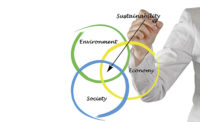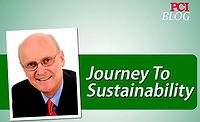Pioneering Sustainability in the Chemical Industry

Credit: Petmal / iStock via Getty Images Plus.
In today's fast-paced industrial landscape, the chemical industry stands at a crossroads. With sustainability concerns taking center stage and the push for green initiatives gaining momentum, finding viable solutions for managing surplus chemicals has become more critical than ever. The repercussions of improper disposal of surplus chemicals are far reaching, impacting both the environment and the economy. It is in this context that pioneering sustainable solutions for surplus chemicals in the chemical industry have emerged as a beacon of hope.
The Problem of Chemical Waste
The chemical industry contributes significantly to sectors such as pharmaceuticals, agriculture, manufacturing and energy. However, managing chemical waste remains a major challenge. Each year, an estimated 400 million tons of hazardous waste is generated worldwide, with the chemical industry being one of the largest contributors. In the United States alone, the Environmental Protection Agency (EPA) reports that more than 30 million tons of hazardous waste are produced annually. Improper disposal of these chemicals can lead to environmental pollution, health hazards and significant economic losses.
Traditional disposal methods, such as incineration, are costly and environmentally damaging. Incineration releases harmful emissions, including greenhouse gases and toxic pollutants. These practices are unsustainable, given the increasing environmental awareness and regulatory pressures. Many chemicals being disposed of can actually be reused for the same purpose they were manufactured for or for a similar purpose. This realization opens up possibilities for rethinking waste management in the chemical industry.
A Sustainable Solution: Reuse and Repurpose
In 2021, recognizing the potential to repurpose surplus chemicals, American Premium Surplus was founded to explore and implement this idea. The concept revolves around helping companies save on disposal costs while providing potential users with access to surplus chemicals, thereby reducing production costs. This approach addresses both environmental and economic challenges.
A comprehensive platform can serve as a marketplace where businesses list their surplus chemicals and connect with potential buyers who can repurpose them. This process involves reaching out to potential users willing to modify their current formulations to utilize these surplus chemicals, thus gaining financial benefits by reducing costs. By facilitating this exchange, significant waste can be diverted from disposal.
Real-World Impact: Case Studies
Pharmaceutical Industry
One of the largest pharmaceutical ingredient suppliers in the world faced the challenge of disposing of 1,100,000 kg of magnesium oxide due to issues with specifications and expiry dates. This disposal would have had a severe environmental impact. However, the surplus was repurposed for concrete and tile production, saving disposal costs and finding a productive use for the material.
Coatings Industry
We found a market for expired or close-to-expiry raw materials, from resins to additives. For example, more than 100,000 kg of acrylic resin are collected each month and sent for reuse in producing low-cost paints. This initiative has reduced waste and provided affordable raw materials for paint production in developing markets.
Agriculture Industry
A manufacturer of ethoxylated castor oil generates around 500,000 kg of surpluses a year from unfulfilled orders and close-to-expiry date products. We found multiple users for it as an emulsifier in agrochemical applications, preventing waste and providing a valuable input for agricultural products.
Chemical Industry
In 2023, we collected around 3,000,000 kg of slightly off-spec diethanolamine and triethanolamine from Europe. We found end users for these chemicals in different countries, where they were safely used as components in cleaning agents and surfactants, ensuring they did not harm the environment or human health.
Polyurethane Industry
Last year, we reused more than 1,000,000 kg of polyols that can be used in insulation and foam production. This surplus was utilized effectively, reducing waste and supporting local industries.
Benefits of Repurposing Surplus Chemicals
Economic Efficiency
End users of repurposed chemicals, such as polyol, acrylic resin and defoamers, benefit from reduced production costs and lower expenditure on raw materials. Suppliers benefit from reduced disposal costs and potential revenue from surplus chemicals.
Environmental Impact
Repurposing surplus chemicals significantly reduces waste that would otherwise be incinerated, lowering emissions of harmful pollutants and reducing the overall environmental impact.
Resource Optimization
Businesses can efficiently manage their chemical inventory, ensuring that surplus chemicals are put to productive use rather than being burned as waste.
Client Willingness to Cooperate
We have been pleasantly surprised by the willingness of many clients around the world to cooperate in reusing chemicals. This cooperation stems from their desire to lower production costs and enhance their competitiveness in various markets. By repurposing surplus chemicals, these clients not only contribute to environmental sustainability, but also gain a significant economic advantage.
Innovative Technologies in Chemical Recycling
Solvent Regeneration
Solvent regeneration technologies enable the recovery and reuse of spent solvents, which are common in many industrial processes. By regenerating solvents, companies can reduce waste, lower raw material costs and minimize environmental impact. This method is particularly effective for industries such as pharmaceuticals and coatings, where solvents are extensively used.
Best Practices for Companies
To effectively manage surplus chemicals, companies should:
- Maintain accurate inventory records to identify surplus materials.
- Establish partnerships with recycling firms and platforms that facilitate the repurposing of surplus chemicals.
- Implement sustainable practices in procurement and production to minimize waste generation.
- Educate employees about the importance of chemical waste management, and encourage innovation in sustainability practices.
Future Trends and Opportunities
The future of surplus chemical management lies in continued innovation and collaboration. Emerging trends such as the circular economy, increased regulatory scrutiny and advancements in recycling technologies will shape the industry. Companies that proactively adopt sustainable practices and invest in innovative solutions will be well positioned to thrive in this evolving landscape.
Challenges and Future Directions
Raising awareness about the benefits of repurposing surplus chemicals remains a significant challenge. Many businesses are still unaware of the economic and environmental advantages of repurposing surplus chemicals. Ongoing education and outreach efforts are crucial in this regard.
There is also ample opportunity for market expansion. Extending services to new regions and industries, leveraging partnerships and collaborations and building a robust network of suppliers and users can further enhance the impact of surplus chemical repurposing.
Conclusion
Addressing the problem of chemical waste through innovative solutions like repurposing surplus chemicals is crucial for environmental sustainability and economic efficiency. By shifting towards a circular economy where waste is minimized and resources are optimized, the chemical industry can significantly reduce its environmental footprint. The commitment to sustainability, innovation and resource optimization is key to paving the way for a more sustainable future.
For more information about repurposing surplus chemicals, visit www.psurplus.com.
Looking for a reprint of this article?
From high-res PDFs to custom plaques, order your copy today!










